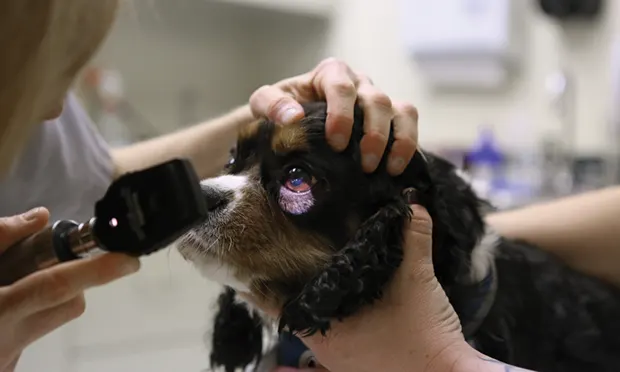Image Quiz: Cataracts and Nuclear Sclerosis in Dogs
Shelby Reinstein, DVM, MS, DACVO, VETgirl, Bucks County, Pennsylvania

Loss of transparency to the lens, caused by both nuclear sclerosis and cataract, is a common finding in dogs. It is important to properly distinguish between these clinical entities, as cataracts require long-term monitoring and treatment.
Nuclear Sclerosis
Nuclear sclerosis, or hardening of the lens nucleus, is a consistent, age-related finding in dogs older than 7 years of age. Clinically, nuclear sclerosis appears as a spherical, opalescent haze to the central nucleus of the lens. The condition does not obscure the tapetal reflection, impede vision, or preclude examination of the retina.
Cataracts
Cataract formation results from abnormal lens metabolism with varying causes and clinical appearances. Cataracts are often classified by cause (eg, inherited, metabolic, age-related, traumatic) and stage of development (eg, incipient, immature, mature, hypermature). Inherited cataracts are commonly seen in middle-aged dogs (eg, bichon frise, Boston terrier, poodle, cocker spaniel). Diabetes mellitus is a common cause of rapidly progressive, bilateral cataract formation in dogs.
Related ArticlesHow to Refer: CataractsImage Gallery: CataractsPainful Ocular Lesion
Incipient cataracts are focal opacities that comprise <15% of the lens volume. They can appear as wedge-shaped, punctate dots, or triangular opacities in the anterior or posterior lens cortex.
Clinically, incipient and immature cataracts are most easily detected using retroillumination by obtaining a tapetal reflection. By allowing the reflection to back-light the cataract, the examiner can delineate the cataract based on the degree of obstruction of the tapetal reflection. This technique can help distinguish cataract from nuclear sclerosis. Mature cataracts completely obscure the tapetal reflection, and hypermature cataracts have a sparkling appearance.
Match the Images
The following images exhibit nuclear sclerosis and cataracts in various stages of development. Match the image with the condition causing a hazy lens.